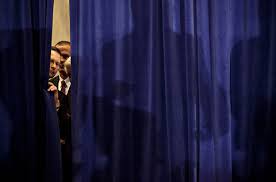This is the first in a four-part series on the televised presidential debates.
With the Democratic and Republican nominees selected, the presidential debates are just around the corner. The venues and dates for Hillary Clinton and Donald Trump’s three bouts are set, but many important details are yet to be worked out, likely behind closed doors.
Facilitating negotiations between the campaigns will be the official sounding but private Commission on Presidential Debates.
The CPD has its work cut out for it. “Given that one of our candidates… is very proud of the fact that he’s good at negotiating deals, it might get complicated,” explained CPD co-chair Mike McCurry.
There’s lots to negotiate. Take something as seemingly mundane as podiums: How high? How far apart? At what angle? Will they be dispatched with for a seated debate?
Then there are more consequential matters, like who will moderate. Not only who but how. A 2012 Memorandum of Understanding between the campaigns of Barack Obama and Mitt Romney outlined:
The moderator will not ask follow-up questions or comment on… questions asked by the audience.
The parties haven’t always exercised so much control over the debates.
League of Women Voters
Shortly before passage of the 19th Amendment in 1920, the League of Women Voters sprang into existence to help women exercise their soon-to-be-won right to vote.
The nonpartisan League began hosting debates, filling a civic void. By the time the League started sponsoring televised presidential debates in 1976, it had decades of experience hosting debates at all levels. That didn’t mean there wasn’t controversy.
In the first debate of the 1980 election, in addition to Jimmy Carter and Ronald Reagan, the League invited Independent John Anderson, who was polling around 15 percent. An outraged Carter sat out the first debate.
In 1984, the League once again asserted its independence, earning the ire of both major parties. When Reagan and his Democratic challenger, Walter Mondale, rejected the names of 83 potential moderators, the League embarrassed the candidates by publicly calling them out.
‘A Fraud on the American Voter’
Fed up with the League’s independence, the two parties hatched a plan. In 1987, they created the Commission on Presidential Debates (CPD), with the Democratic and Republican chairmen serving as the organization’s co-chairs.
In the 1988 election, the major party candidates quickly agreed to participate in CPD-sponsored debates, effectively sidelining the League.
The resulting debates were “phony, part of an unconscionable fraud,” said CBS anchorman Walter Cronkite.
It’s “a charade,” said CNN’s Bernard Shaw, “these were not debates.”
It’s “a fraud on the American voter,” said the League, which ceased involvement so as to avoid “becoming an accessory to the hoodwinking of the American public.”
Corporate Money
With the civic-minded League out, money poured in. Anheuser-Bush and Philip Morris, among other corporations, provided large donations, and in return were featured prominently at the CPD debates.
When George Farah – author of No Debate, an expose of the CPD – asked about the propriety of beer and tobacco companies sponsoring presidential debates, Frank Fahrenkopf replied:
Boy, you are talking to really the wrong guy. I’m a guy who represents the gambling industry.
But Fahrenkopf doesn’t just represent gambling interests, he’s also the Republican CPD co-chair, a position he’s held since CPD’s inception nearly thirty years ago.
Fahrenkopf’s Democratic counterpart, McCurry, is also a lobbyist. After serving as Bill Clinton’s press secretary, McCurry went on to lobby for, among others, telecoms seeking to kill net neutrality.
The other 15 CPD board members are mostly party insiders and donors.
This (bi)partisan board, along with the two major party nominees, serves as gatekeeper to the presidential debates every four years.
Next up: How Third Parties are Kept Out of Presidential Debates

